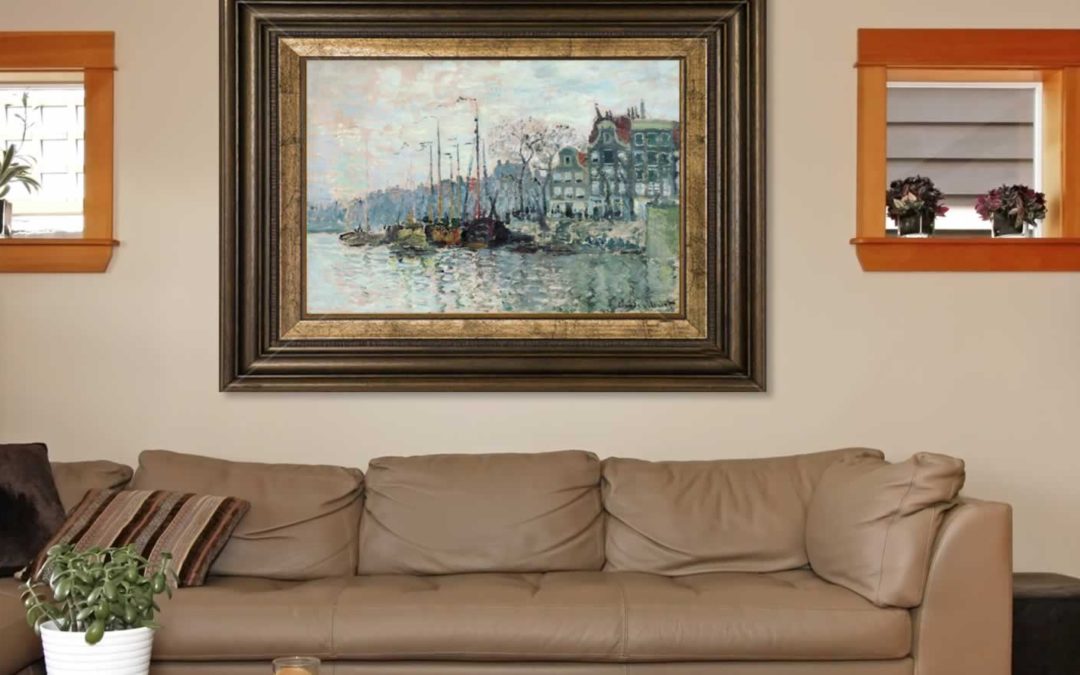Digital art frames are becoming a universal decoration in many homes and businesses. The picture quality, digital frame design and set of features have significantly improved over earlier models. When you are shopping for a large digital photo frame, there are few things to learn before you purchase.
1. Size matters.
One of the first things to consider when buying a digital art frame is the size. Most wall-mounted digital frames have a higher resolution screen so you don’t see the pixels in the image. The larger the screen, the more resolution you need. Most current screen sizes look great at 1080p resolution. A 4K screen is overkill until you get into the larger screens. You want to get a digital photograph frame with the right resolution for its size so that images are sharp, and you don’t want to overpay for features you cannot use. The screen size is not the same as the frame size. Frame size is the length x height of the physical frame. Screen size is the actual part of the frame that displays the art.
2. Display options.
Digital photograph frames are wall-mounted and can be displayed in either landscape or portrait mode. Make sure the digital frame comes with mounting brackets that can support the frame on the wall. The way you hang your digital frame depends on how you take pictures and what type of art you want to display. For photos, do you hold your camera horizontally or vertically? For moving art, the landscape display seems more prevalent right now, but that can change as artists start to embrace this new medium.
Custom framing is another consideration. Can you buy your own frame that matches your décor and insert a digital photo frame into it? Some companies offer this option, while other companies have a limited selection of frames that work with their product.
Viewing angle. When buying a wall-mounted digital art frame, make sure you can see the images from any position in the room. The viewing angle should be very wide with very little degradation in the image quality. Most digital frames have some level of glare if they are in a room with direct sunlight. It is recommended that digital art frames hang on a wall where there is no direct sunlight.
Matte or glossy displays. While a matte digital photograph frame reduces glare and reflections, it also changes the way the art looks. Some people prefer a matte presentation for “paint brush” art because it gives a textured look. However, on photographic art, it can wash out the image and significantly reduce the quality of the image.
3. Bandwidth.
Most digital art frames are Wi-Fi-enabled. They consume bandwidth and data to transfer art from the cloud service to the frame. Digital frame companies that do not store art in the frame can use a lot of data. For example, streaming motion uses a lot of data. Some frames may require a constant Wi-Fi connection to work. This is a hint that the frame will use more data because it’s not storing the images locally. Whatever brand you buy, make sure you know how it uses bandwidth and data, especially if your bandwidth is limited or you pay for extra data usage.
4. Storage capacity.
Some digital photo frames have their own storage system using internal memory, and some are Wi-Fi only, which means nothing can be displayed without an internet connection. The average amount of internal memory is 8 to 80 GB for wall-mounted digital frames. Some digital frames have expandable memory slots or a USB port. Be aware of how much memory you might need. Motion art and 4K images can take large amounts of storage space. A good high-quality image takes about half a MB, and a good quality piece of moving art can get into the 20MB+ range. If you have a large volume of high-quality images, an 8GB frame will be too small.
5. Remote management.
Older versions of digital art frames used a remote control to change the displayed image. Today it is more common for digital frames to use computer or mobile apps to schedule how often and what images are displayed, as well as other settings such as brightness and mode changes. Check what functions are available and if they work with your usage. For example, if you are setting up a digital frame at grandma’s house, you need the ability to make changes without being present in the room.
6. Cloud based.
When you are displaying art in a digital frame, a cloud-based system not only offers a considerable selection of genres and collections from art museums around the world, it also stores your playlists, personal photos and settings in the cloud. This means you can easily add or replace a digital photo frame.
7. Security.
Digital art frames should have a good level of security to protect your personal photos as well as protecting an artist’s image from being copied. The Wi-Fi network that supports your digital art frame should be password-protected.
8. User interface.
Some digital frames have a user interface that gives you control over when, where and how the frame displays the image. Other digital photograph frames are only controllable from a web portal or mobile device. Some digital frames have touchscreen functionality, while others have buttons on the side of the frame. User interfaces will continue to evolve as digital art frame technology becomes more well known. Consider the location of your digital photo frame. Can you physically get to the digital frame to push the buttons or touch the screen? You do not want to crawl over a couch or use a ladder to change pictures. Mobile phone apps are very convenient and allow you to change the art and settings from anywhere. Compare how the features and functions of the digital frame will work before you buy.
9. Uploading photos.
Another consideration is the ease in which you can upload your own photos. Older small digital frames required you to copy photos to a memory card or stick and then physically insert it into the frame. Newer digital art frames are Wi-Fi based so you can use your computer or phone to upload the photos.
10. Sharing.
The newest digital photograph frames allow you to share personal images from your digital frame to family and friends or even your social networks. Sharing works best if both parties have a frame from the same manufacturer. Check which frames allow direct sharing. If your digital art frame offers a subscription service to museum art collections, those images are copyrighted and cannot be shared socially. Remember that images shared on digital art frames will appear on your friend’s digital frame as a work of art. Be careful that what you share is appropriate for their enjoyment.
11. Moving art.
Moving art is similar to an animated GIF image or a video loop without audio. If you search YouTube for moving art, you will find looped videos of oceans, clouds, forests and other scenic places. The latest digital art frames support moving art. If this is a must-have feature, make sure the digital frame you select offers it. An extension of moving art is streaming views. Some digital art frames connect with streaming cameras around the world. Streaming views require more bandwidth from your internet service, but it offers beautiful and unique art. For example, the Panda-Cam at the Chinese zoo, or the beach in Bora Bora.
12. Playlists.
Just like a music playlist, you can create an art playlist that contains all your favorite images that are displayed in a digital photo frame. The images can be either personal photos or art from museum collections, or a mix of both. If this feature is important to you, make sure the digital photograph frame supports the ability to create your own playlist. The difference between a music playlist and an art playlist is that art does not have a duration. Make sure the art playlist feature allows you to control how long each piece of art is displayed. For example, you may want the Rembrandt playlist to show each image in the collection for an entire day. In comparison, a playlist of photos from your child’s birthday should change the image every minute.
13. Cost.
Look at the cost of each digital art frame and compare the features and benefits based on what features are most important to you. The average price range for wall-mounted digital frames is $500 – $1000. Some companies sell the digital photo frame only, and some companies offer a monthly subscription that allows access to museum art collections. The subscription fee ranges from $5 – $20 per month.
A wall-mounted digital frame that shows off your favorite art collections and personal photography on a high-resolution screen will be the main conversation point at your next gathering.
About Nimbus Frames
Nimbus creates large wall-mounted digital art frames that come in two sizes and can be displayed in portrait or landscape orientation. The Nimbus digital art canvas comes with a black display frame, or it can be inserted into a custom frame of your own choosing. It has low bandwidth and high storage capacity. The Nimbus art collection consists of more than 500,000 pieces, including museum-quality art from galleries around the world.

